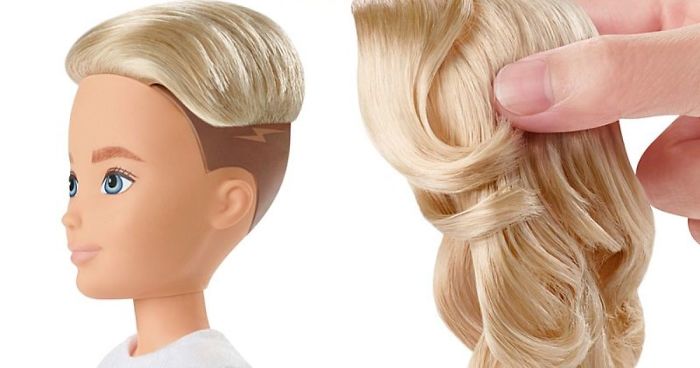
Barbie Manufacturer Launches A Gender Neutral Doll Collection ‘Free Of Labels’
This doll can be a boy, a girl, neither, or both. Mattel, the same company that created Barbie dolls, calls it the world’s first gender-neutral doll and hopes to redefine who gets to play with what, erasing the traditional taboos and gender roles.
“Kids’ toys are a reflection of culture and as the world continues to celebrate the positive impact of inclusivity, we felt it was time to create a realistic doll line free of labels,” Kim Culmone, Senior Vice President of Mattel Fashion Doll Design said.
Image credits: Mattel
Image credits: Mattel
Image credits: Mattel
Image credits: Mattel
Image credits: Mattel
Image credits: Mattel
Image credits: Mattel
Image credits: Mattel
Image credits: Mattel
Image credits: Mattel
The versatile new dolls are available in a variety of skin tones. They can be styled with a long-haired wig and dressed in pants, a skirt, or shorts, as well as three different styles of shoes, sunglasses, and other accessories. Like TIME noted, the 11-inch dolls’ “lips are not too full, the eyelashes not too long and fluttery, the jaw not too wide. There are no Barbie-like breasts or broad, Ken-like shoulders,” the magazine said.
Image credits: Mattel
Image credits: Mattel
For quite some time, millennial parents have pushed back against gender stereotypes in toy. And major sellers have been listening. Their buying habits already influenced Disney banish “boys” and “girls” labels from its children’s costumes, inviting girls to dress as Captain America and boys as Belle. Last year, Mattel also did away with “boys” and “girls” toy divisions, replacing them with non-gendered sections, for example, dolls or cars.
Image credits: Mattel
Image credits: Mattel
Image credits: Mattel
Image credits: Mattel
These dolls should sell $29.99 a pop, with the slogan “A doll line designed to keep labels out and invite everyone in.” With this move, the company is betting on where it thinks the country is going, even if it means alienating a substantial portion of their buyers. According to a Pew Research survey, while 76% of the public supports parents’ steering girls to toys and activities traditionally associated with boys, only 64% endorse steering boys toward toys and activities associated with girls.
this isn't supposed to be a political statement, it's just a doll that gives kids more ways to play, more characters to make. nowhere does it say that children are being encouraged to change genders, some people look at an article with the word "gender" in it and write an angry comment about how western civilization is being destroyed because of all the evil transgenders influencing children!!!! or something like that. no, it's a doll that is giving children a CHOICE of what they want to dress their doll up or play with, if you think it's supposed to be malicious, take a break from the internet.
I grew up never been held to any girl story type. where I was allowed to do girl stuff and boy stuff. did it make me wanna change gender no. it made me think there isn't really a difference
Load More Replies...I really love the way it's a child's toy with a child's body. It looks like a little kid. No big boobs, or broad shoulders. Never understood the over-sexed look of Barbie to begin with.
It's a 50s thing, modeled on a real woman rather than a kid..... I'm guessing it was all fellas in the design 'team' and boardroom.
Load More Replies...I love this. I love the idea that a doll can be so versatile, that kids can create a toy that reflects them or their friends and not have to worry about if it's a toy coded for girls or boys. Forget the gender neutral aspect of it for a minute and remember it's a toy for kids who are generally not as aware of or hung up on ideas of gender or sexuality as their adult caretakers may be. This is a toy they can mod and play with to better reflect themselves or what their current likes are. I think it's an awesome idea.
This is really good! Although, if you're into action figures, you might have come across the fully customisable and neutral doll bases to create your own characters. Still, I like the initiative. It encourages creativity.
Yup, same as I would make all kinds of characters with LEGOs when I was a kid, I can see this being very good for the kids creativity, as long as there are enough options.
Load More Replies...I can’t believe all the people getting bent out of shape over this. This doll is awesome, there is like 100+ dolls in one. How about don’t focus on the title of this thread and see this doll for what it is. It’s a versatile doll that can change character however the child wants with however they feel like at the time. I can’t count how many times I cut my dolls hair to make different hairstyles, this doll you can interchange them without ruining the doll. Come on people stop getting outraged over nothing, ever heard the term click bait?
The Concrete Christians are going to have a COW over this. After all, they're a lot of why girls are held to 'women's roles'.
Load More Replies...I would've loved this as a child ! I remember always being put out by the fact that you couldn't change the hairstyle of the barbies and that you had to buy extra if you wanted a guy even though I didn't use them often.
I'm a gender neutral person, and I really like the idea. There's a lot of choices. I'm quite sad I didn't get to play with these dolls when I was little ;-;
Whoah, thanks a lot guys ^^ Sex and gender can be different. That's just based on how you "feel". You didn't need to be rude... '-'
Load More Replies...1st thought on this: Barbie without makeup. Additional thoughts: this is kinda cool with the apparel variety of the doll. I'm a woman and never really cared for Barbie and other dolls as a little girl, my parents got me Legos, ninja turtles, and adorable plushies. I'd let my son get a doll if he wants wants 1 even though he likes superheroes. Just let kids play with what brings them joy, unless it's sharp.
I'm' very lucky - I'm female but even 50 yeas ago I played with trucks and boats, not dolls and tea sets, and my parents never pressured me to choose differently.
Load More Replies...I would have LOVED that as a child - not because of the gender neutrality (I wouldn't have even understood that) but because of the cool clothes different hair styles.
I would've loved having this as a child. Barbie didn't work for me as she was all high heels and dresses and fashion and I absolutely was not that girl. Kids will play with this not as gender fluid but as a doll with so many options. Not all girls have long hair and want to wear skirts. Not all boys have short hair and want to wear pants. (Can't imagine wanting to wear skirts or dresses myself but to each their own)
Nor did she fit on the fancy model horses--the ones that looked good, not the horrors Mattel produced later.
Load More Replies...Yes yes yes! My son always wanted a barbie but never found one he really liked. He likes violett but he hates pink. But barbie is ... was all about pink...
This is brilliant work! I give them credit for reaching out to those that are in need of this kind of product! For those of you that condemn this product and say: "It's the end of western civilization", etc, I am sorry that you feel that way. Western civilisation is not coming to an end. It is merely evolving, just as human civilisation has done for the last 200,000 years. That's what humans do. We evolve, we learn, we adapt, we grow. I hope you can too.
😂😂 Right?? So many awesome accessories....to never be able to find again!
Load More Replies...How about: kids can wear whatever clothes and have whatever haircut they want without pretending to be the opposite sex. Sex doesn't determine personality. Personality doesn't determine sex. No obfuscation or lies required.
Maybe what people are looking for is to be TREATED like they would be treated if they were the sex/gender they see themselves as.
Load More Replies...This is such a good idea! Several dolls and story lines in one. Pretty cool.
yay! non-binary and genderfluid pride! -Agender Furry Bestie :P
Load More Replies...I actually think it’s cool. It’s a make-your-own Barbie. Stop being so worried about which bathroom it’s going to go in.
This is reflecting the world around us! This is a fantastic move on their part! This isn't the '50's anymore, where kids are bound to a stereotype.
I love it. So many children do not see themselves reflected in anything. Such a positive way to say you are awesome as you are.
Wonderful idea. :) I have seen videos about Japanese ball-jointed dolls that have very much options for customization and you can buy various body parts separately to get the unique look to your doll. But those dolls are very expensive to order from Asia so it is good that there will be more cheaper customisable dolls from Mattel. :)
i kinda love this....it opens kids up to self expression and allows them to explore who they are and want to be.
I might accualy cry. I'm not even kidding. This means so much to me because all the Barbie's that I have ever seen were women and I felt I wasent "girly" because I'm not. All the other girls when I was younger would play with Barbie's and I would try to fit in and join them but it always felt wrong playing as a "girl" this gives kids, (like me) who are non-binary, transgender, genderqueer, Gender fluid, and anything else (sorry if I didn't in life some I don't know all of them.) I think there should be more dolls like this that will include everyone. We also need to add third gender restrooms but that's a debate for a different day.
awwww don't cry! this is a happy time and we all are happy :) *gives you virtual hug*
Load More Replies...I think it's about time. Children do not identify with gender until they are about 10 years old. So why not let children dress up in clothes that entice them by color, style, or what ever ;look they like. Thank you Mattel.
I'm on the fence about this. While I see the positive in this being an awesome creative toy I also see the negative in this being confusing for a child. I am old fashion and still think gender roles are very important to society. I would think that a toy like this is going to give kids the idea that there is no gender or that you can pick your gender, which I don't agree with.
It won't confuse kids. A boy who's a rock throwing, fort making, rough and tumble boy won't do "gee, this doll can be a boy or a girl. I guess I'll start wearing dresses now". A doll won't make you think differently about "what" you are. If you are trans then you are trans independent of what a doll from the store might get in your head. And if somehow you do get influenced, it won't last long because eventually you'll figure yourself out as fas as "who" you are.
Load More Replies...There are so many comments below saying "this is ridiculous!!" and "What has our world come to?". People are expressing themselves because WE DON'T LIVE IN THE STONE AGE. Stop whining about other people's beliefs and do something productive. Gosh. I'm a huge fan of this doll.
I love these! My son loves all kinds of toys and clothes but at the moment, as we live in a bit of a rough area, we only allow him to wear his pink, sparkly, unicorn, Princess etc. clothing indoors as we worry for his safety. If toys like these open people's hearts and minds to the fact that what's in your pants should have no bearing on how you like to dress, look or play, this can only be a positive thing.
I am SO GLAD these dolls were created and they will benefit kids of all identities. Me and my sister were given so many different options on how to choose our toys, clothes and hobbies. We were never made to do anything "for girls" just because we are female. For example, my sister loved playing with other boys and cars, and I liked princesses and climbing trees. This helped us develop our own unique personalities and not feel like we had to be who were weren't, which the toys help foster. Our freedom never pushed us to transition to a different sex or make us confused about our gender.
I think this is great, however it seems a bit odd to me that by changing the hairstyle the doll is suddenly said to be a different gender, because gender expression is not by any means determined simply by the length of one's hair.
At that age, it kind of is. Unless I'm missing something? Seems like hair + clothes would be enough. It's not until you're older that you need to worry about binding, shaving, make-up, etc.
Load More Replies...I love that this gives boys and girls moe options with their dolls. I do not see it being gender bias. I see it as having more options with a doll. What child doesn't like switching out the hair to go with the clothes? Is this really an issue? Open your minds people. Shut up and let the kids play. Playing with dolls is not going to determine who the child is or who they grow up to be. Get over it, prudes!
Last I checked, Barbies never had any genitals. But I'm glad they are finally moving away from the girlie Barbie model. Next on my list is to stop making black dolls look just like the white dolls except but brown.
Gender identity isn't tied to genitals anyway, so that's irrelevant.
Load More Replies...I would have loved these as a kid. It more than doubles your options with one doll.
This doll is so pretty that when you put long hair on it, it automatically looks like a girl. Seriously, I had a "genderless" doll (a baby, more like), and I still decided it would be a girl. So, the way that new doll's gonna be dressed will define its gender anyway. And it the end, most kids (still girls) will choose their doll to be a girl or a boy. So calm down, this is just one more option in terms of toys. Just like clothing with pockets. I didn't like wearing dresses for one reason: no pockets.
This is awesome!! You can just go like "oh no, i olnly have two Barbies and one needs to be a boy" and BAM. So useful.
This is such a wonderful idea! And really cool doll designs, too. I don't think I've ever seen doll Dr Martens before--much less awesome sparkly ones!
These already existed. I had Liv dolls as a kid, which allowed you to change the hair and came with more diverse clothing options
Anyone remember Skipper from my childhood, with her disappearing breasts? if you rotated one arm clockwise, they appeared, and you had a teenager. Counterclockwise, and you had a preteen. (They didn't last long. I don't know if it was because they didn't sell of if they broke so easily.)
Hello everyone! I just came across this drawing video. I thought you might like it so I'm sharing this.hope you all also find it useful #kidsdrawing #HowTodrawOnion #HowTodrawLamp ##HowTodrawSocks #HowTodrawKey #HowTodraw #DrawingForBeginners #DrawingForKids #kidsdrawingTutorial https://www.youtube.com/watch?v=_qb7jmhmXnA
Love it though as we all know With barbie accessories the long wig will vanish into oblivion fast. How easy us the long hair to brush? Will the wig get matted in days and then end up chucked away? At least it ends the long history of little girls with scissors creating terrible hair styles
Well if a child likes a barbie princess in a dress they only like that because they are taught too, same for action figures too, though both genders from a young age could be influenced into this. Like they can be influenced into liking this toy if they have it from an early age. I'm not saying I neccessarily care that it's gender neutral, though being that does give it more flexibility. However they could of made it the same way as a boy or girl toy and just labelled it "non-binary" Also what gender would they base the model on? It's not like a kid would decide on being non-binary without influence, just as they wouldn't for the stereotypical standard of female and male. So they must look at a boy or girl kid for refference, right? Unless there are actually kids that have been influenced into being non binary, or rather, maybe it's a lack of gender influence which I don't disagree with but I doubt a kid would know what non binary means unless you or something tells them.
Load More Replies...Dolls already have no gender. They're made of plastic. What is going on with the world?
By your logic, humans have no gender; they're made of meat.
Load More Replies...Nice toy..... But what's this weird thing where everyone's confusing gender with sexuality. It makes no sense whatsoever.
I think we s pop end far too much time and money worrying about this. I grew in p with big boobies Barbie and plastic haired Ken (I did have trouble with the fact that he didn't have "real" hair) and I am normal, accepting, and relatively well adjusted given our political climate. Worry about their education, their cost of living, employment availability, senior health benefits. Teach them that nobody is unacceptable and let this other stuff go.
seriously? what next? gender neutral chairs? oh wait, they already have those.
Mattel has jumped on the "confuse the s**t out of your kids!" bandwagon. F**k Mattel.
Nah, they've jumped on the 'more money, how will it sell' bandwagon.
Load More Replies...Gender dysphoria is a mental illness. Pretending it's not is America's current PC obsession.
I think it's a cute idea and the kids will have fun with it, but the doll is going to suffer an identity crisis. One thing about my Tiny Tears doll in the '50s -- she always knew who she was! >grin<
She's already on the shelves. She's not really obese, though; she just has thunder thighs and smaller breasts. I guess no one told Mattel that when you get fat, everything gets fat.
Load More Replies...It's so ridiculous, bunch of sheep doing what they're told. Let kids be kids
you are correct, but there are multiple gender expressions! excuse me if I am getting this wrong because I need to do a bit more reading up on this, but just realize that people can express themselves however they feel like they are. Please open your mind and have a wonderful day <3
Load More Replies...Yeah, great idea!! Let's take the ability for children to use their imaginations right off the table and we will do everything for everyone instead....(mumbles something about someone being dumbasses)
Plus it's still a huge corporation so chill with the over-the-top praise
Load More Replies...But it helps show that however you identify, you are normal and loved and it takes away some societal pressure
Load More Replies...Oh my goodness, I grew up watching movies with ONLY straight people in it. I am now a trans, pansexual man. Also, I had ALOT of barbies
Load More Replies...The word is masculine. There is no such thing as masculent! And most prepubescent children do look gender neutral -- it's only by their clothes or hair that we make them "look like" boys or girls.
Load More Replies...I'm not a Psychologist but isn't it better/ healthier for a child to have the freedom to develop their own mind instead of being pushed in one way or the other? Girls have it better these days because a girl can play with anything. But if a boy wants to play with dolls many people would try to persuade him that those are girl toys and he should select something for boys. But why tough? Why must he play with boy toys? A doll will not make him gay or whatnot. He should have the same right to play with anything he likes, just like a girl. And to make it easier for him in an unsupportive environment gender neutral toys are a good step toward equality. Let HIM discover what he likes and dislikes and what he will grow up to be!
Load More Replies...Ah, I see how you spent your childhood, or worse, adulthood.
Load More Replies...If you'd read what Mattel had to say about it - you'd knew - the doll represents a body of average 7 yr old CHILD.
Load More Replies...Not so -- Barbie has no vulva, Ken has no genitals at all.
Load More Replies...Gender and sexuality are two different things..... How'd everyone get that so wrong..?
Load More Replies...it's a doll, if you think that this barbie is encouraging children to "mutilate their genitals" because you can let your boy doll wear a skirt, you're the one with the issue.
Load More Replies...that's a bit over dramatic, if you have an issue with it, don't buy it.
Load More Replies...this isn't supposed to be a political statement, it's just a doll that gives kids more ways to play, more characters to make. nowhere does it say that children are being encouraged to change genders, some people look at an article with the word "gender" in it and write an angry comment about how western civilization is being destroyed because of all the evil transgenders influencing children!!!! or something like that. no, it's a doll that is giving children a CHOICE of what they want to dress their doll up or play with, if you think it's supposed to be malicious, take a break from the internet.
I grew up never been held to any girl story type. where I was allowed to do girl stuff and boy stuff. did it make me wanna change gender no. it made me think there isn't really a difference
Load More Replies...I really love the way it's a child's toy with a child's body. It looks like a little kid. No big boobs, or broad shoulders. Never understood the over-sexed look of Barbie to begin with.
It's a 50s thing, modeled on a real woman rather than a kid..... I'm guessing it was all fellas in the design 'team' and boardroom.
Load More Replies...I love this. I love the idea that a doll can be so versatile, that kids can create a toy that reflects them or their friends and not have to worry about if it's a toy coded for girls or boys. Forget the gender neutral aspect of it for a minute and remember it's a toy for kids who are generally not as aware of or hung up on ideas of gender or sexuality as their adult caretakers may be. This is a toy they can mod and play with to better reflect themselves or what their current likes are. I think it's an awesome idea.
This is really good! Although, if you're into action figures, you might have come across the fully customisable and neutral doll bases to create your own characters. Still, I like the initiative. It encourages creativity.
Yup, same as I would make all kinds of characters with LEGOs when I was a kid, I can see this being very good for the kids creativity, as long as there are enough options.
Load More Replies...I can’t believe all the people getting bent out of shape over this. This doll is awesome, there is like 100+ dolls in one. How about don’t focus on the title of this thread and see this doll for what it is. It’s a versatile doll that can change character however the child wants with however they feel like at the time. I can’t count how many times I cut my dolls hair to make different hairstyles, this doll you can interchange them without ruining the doll. Come on people stop getting outraged over nothing, ever heard the term click bait?
The Concrete Christians are going to have a COW over this. After all, they're a lot of why girls are held to 'women's roles'.
Load More Replies...I would've loved this as a child ! I remember always being put out by the fact that you couldn't change the hairstyle of the barbies and that you had to buy extra if you wanted a guy even though I didn't use them often.
I'm a gender neutral person, and I really like the idea. There's a lot of choices. I'm quite sad I didn't get to play with these dolls when I was little ;-;
Whoah, thanks a lot guys ^^ Sex and gender can be different. That's just based on how you "feel". You didn't need to be rude... '-'
Load More Replies...1st thought on this: Barbie without makeup. Additional thoughts: this is kinda cool with the apparel variety of the doll. I'm a woman and never really cared for Barbie and other dolls as a little girl, my parents got me Legos, ninja turtles, and adorable plushies. I'd let my son get a doll if he wants wants 1 even though he likes superheroes. Just let kids play with what brings them joy, unless it's sharp.
I'm' very lucky - I'm female but even 50 yeas ago I played with trucks and boats, not dolls and tea sets, and my parents never pressured me to choose differently.
Load More Replies...I would have LOVED that as a child - not because of the gender neutrality (I wouldn't have even understood that) but because of the cool clothes different hair styles.
I would've loved having this as a child. Barbie didn't work for me as she was all high heels and dresses and fashion and I absolutely was not that girl. Kids will play with this not as gender fluid but as a doll with so many options. Not all girls have long hair and want to wear skirts. Not all boys have short hair and want to wear pants. (Can't imagine wanting to wear skirts or dresses myself but to each their own)
Nor did she fit on the fancy model horses--the ones that looked good, not the horrors Mattel produced later.
Load More Replies...Yes yes yes! My son always wanted a barbie but never found one he really liked. He likes violett but he hates pink. But barbie is ... was all about pink...
This is brilliant work! I give them credit for reaching out to those that are in need of this kind of product! For those of you that condemn this product and say: "It's the end of western civilization", etc, I am sorry that you feel that way. Western civilisation is not coming to an end. It is merely evolving, just as human civilisation has done for the last 200,000 years. That's what humans do. We evolve, we learn, we adapt, we grow. I hope you can too.
😂😂 Right?? So many awesome accessories....to never be able to find again!
Load More Replies...How about: kids can wear whatever clothes and have whatever haircut they want without pretending to be the opposite sex. Sex doesn't determine personality. Personality doesn't determine sex. No obfuscation or lies required.
Maybe what people are looking for is to be TREATED like they would be treated if they were the sex/gender they see themselves as.
Load More Replies...This is such a good idea! Several dolls and story lines in one. Pretty cool.
yay! non-binary and genderfluid pride! -Agender Furry Bestie :P
Load More Replies...I actually think it’s cool. It’s a make-your-own Barbie. Stop being so worried about which bathroom it’s going to go in.
This is reflecting the world around us! This is a fantastic move on their part! This isn't the '50's anymore, where kids are bound to a stereotype.
I love it. So many children do not see themselves reflected in anything. Such a positive way to say you are awesome as you are.
Wonderful idea. :) I have seen videos about Japanese ball-jointed dolls that have very much options for customization and you can buy various body parts separately to get the unique look to your doll. But those dolls are very expensive to order from Asia so it is good that there will be more cheaper customisable dolls from Mattel. :)
i kinda love this....it opens kids up to self expression and allows them to explore who they are and want to be.
I might accualy cry. I'm not even kidding. This means so much to me because all the Barbie's that I have ever seen were women and I felt I wasent "girly" because I'm not. All the other girls when I was younger would play with Barbie's and I would try to fit in and join them but it always felt wrong playing as a "girl" this gives kids, (like me) who are non-binary, transgender, genderqueer, Gender fluid, and anything else (sorry if I didn't in life some I don't know all of them.) I think there should be more dolls like this that will include everyone. We also need to add third gender restrooms but that's a debate for a different day.
awwww don't cry! this is a happy time and we all are happy :) *gives you virtual hug*
Load More Replies...I think it's about time. Children do not identify with gender until they are about 10 years old. So why not let children dress up in clothes that entice them by color, style, or what ever ;look they like. Thank you Mattel.
I'm on the fence about this. While I see the positive in this being an awesome creative toy I also see the negative in this being confusing for a child. I am old fashion and still think gender roles are very important to society. I would think that a toy like this is going to give kids the idea that there is no gender or that you can pick your gender, which I don't agree with.
It won't confuse kids. A boy who's a rock throwing, fort making, rough and tumble boy won't do "gee, this doll can be a boy or a girl. I guess I'll start wearing dresses now". A doll won't make you think differently about "what" you are. If you are trans then you are trans independent of what a doll from the store might get in your head. And if somehow you do get influenced, it won't last long because eventually you'll figure yourself out as fas as "who" you are.
Load More Replies...There are so many comments below saying "this is ridiculous!!" and "What has our world come to?". People are expressing themselves because WE DON'T LIVE IN THE STONE AGE. Stop whining about other people's beliefs and do something productive. Gosh. I'm a huge fan of this doll.
I love these! My son loves all kinds of toys and clothes but at the moment, as we live in a bit of a rough area, we only allow him to wear his pink, sparkly, unicorn, Princess etc. clothing indoors as we worry for his safety. If toys like these open people's hearts and minds to the fact that what's in your pants should have no bearing on how you like to dress, look or play, this can only be a positive thing.
I am SO GLAD these dolls were created and they will benefit kids of all identities. Me and my sister were given so many different options on how to choose our toys, clothes and hobbies. We were never made to do anything "for girls" just because we are female. For example, my sister loved playing with other boys and cars, and I liked princesses and climbing trees. This helped us develop our own unique personalities and not feel like we had to be who were weren't, which the toys help foster. Our freedom never pushed us to transition to a different sex or make us confused about our gender.
I think this is great, however it seems a bit odd to me that by changing the hairstyle the doll is suddenly said to be a different gender, because gender expression is not by any means determined simply by the length of one's hair.
At that age, it kind of is. Unless I'm missing something? Seems like hair + clothes would be enough. It's not until you're older that you need to worry about binding, shaving, make-up, etc.
Load More Replies...I love that this gives boys and girls moe options with their dolls. I do not see it being gender bias. I see it as having more options with a doll. What child doesn't like switching out the hair to go with the clothes? Is this really an issue? Open your minds people. Shut up and let the kids play. Playing with dolls is not going to determine who the child is or who they grow up to be. Get over it, prudes!
Last I checked, Barbies never had any genitals. But I'm glad they are finally moving away from the girlie Barbie model. Next on my list is to stop making black dolls look just like the white dolls except but brown.
Gender identity isn't tied to genitals anyway, so that's irrelevant.
Load More Replies...I would have loved these as a kid. It more than doubles your options with one doll.
This doll is so pretty that when you put long hair on it, it automatically looks like a girl. Seriously, I had a "genderless" doll (a baby, more like), and I still decided it would be a girl. So, the way that new doll's gonna be dressed will define its gender anyway. And it the end, most kids (still girls) will choose their doll to be a girl or a boy. So calm down, this is just one more option in terms of toys. Just like clothing with pockets. I didn't like wearing dresses for one reason: no pockets.
This is awesome!! You can just go like "oh no, i olnly have two Barbies and one needs to be a boy" and BAM. So useful.
This is such a wonderful idea! And really cool doll designs, too. I don't think I've ever seen doll Dr Martens before--much less awesome sparkly ones!
These already existed. I had Liv dolls as a kid, which allowed you to change the hair and came with more diverse clothing options
Anyone remember Skipper from my childhood, with her disappearing breasts? if you rotated one arm clockwise, they appeared, and you had a teenager. Counterclockwise, and you had a preteen. (They didn't last long. I don't know if it was because they didn't sell of if they broke so easily.)
Hello everyone! I just came across this drawing video. I thought you might like it so I'm sharing this.hope you all also find it useful #kidsdrawing #HowTodrawOnion #HowTodrawLamp ##HowTodrawSocks #HowTodrawKey #HowTodraw #DrawingForBeginners #DrawingForKids #kidsdrawingTutorial https://www.youtube.com/watch?v=_qb7jmhmXnA
Love it though as we all know With barbie accessories the long wig will vanish into oblivion fast. How easy us the long hair to brush? Will the wig get matted in days and then end up chucked away? At least it ends the long history of little girls with scissors creating terrible hair styles
Well if a child likes a barbie princess in a dress they only like that because they are taught too, same for action figures too, though both genders from a young age could be influenced into this. Like they can be influenced into liking this toy if they have it from an early age. I'm not saying I neccessarily care that it's gender neutral, though being that does give it more flexibility. However they could of made it the same way as a boy or girl toy and just labelled it "non-binary" Also what gender would they base the model on? It's not like a kid would decide on being non-binary without influence, just as they wouldn't for the stereotypical standard of female and male. So they must look at a boy or girl kid for refference, right? Unless there are actually kids that have been influenced into being non binary, or rather, maybe it's a lack of gender influence which I don't disagree with but I doubt a kid would know what non binary means unless you or something tells them.
Load More Replies...Dolls already have no gender. They're made of plastic. What is going on with the world?
By your logic, humans have no gender; they're made of meat.
Load More Replies...Nice toy..... But what's this weird thing where everyone's confusing gender with sexuality. It makes no sense whatsoever.
I think we s pop end far too much time and money worrying about this. I grew in p with big boobies Barbie and plastic haired Ken (I did have trouble with the fact that he didn't have "real" hair) and I am normal, accepting, and relatively well adjusted given our political climate. Worry about their education, their cost of living, employment availability, senior health benefits. Teach them that nobody is unacceptable and let this other stuff go.
seriously? what next? gender neutral chairs? oh wait, they already have those.
Mattel has jumped on the "confuse the s**t out of your kids!" bandwagon. F**k Mattel.
Nah, they've jumped on the 'more money, how will it sell' bandwagon.
Load More Replies...Gender dysphoria is a mental illness. Pretending it's not is America's current PC obsession.
I think it's a cute idea and the kids will have fun with it, but the doll is going to suffer an identity crisis. One thing about my Tiny Tears doll in the '50s -- she always knew who she was! >grin<
She's already on the shelves. She's not really obese, though; she just has thunder thighs and smaller breasts. I guess no one told Mattel that when you get fat, everything gets fat.
Load More Replies...It's so ridiculous, bunch of sheep doing what they're told. Let kids be kids
you are correct, but there are multiple gender expressions! excuse me if I am getting this wrong because I need to do a bit more reading up on this, but just realize that people can express themselves however they feel like they are. Please open your mind and have a wonderful day <3
Load More Replies...Yeah, great idea!! Let's take the ability for children to use their imaginations right off the table and we will do everything for everyone instead....(mumbles something about someone being dumbasses)
Plus it's still a huge corporation so chill with the over-the-top praise
Load More Replies...But it helps show that however you identify, you are normal and loved and it takes away some societal pressure
Load More Replies...Oh my goodness, I grew up watching movies with ONLY straight people in it. I am now a trans, pansexual man. Also, I had ALOT of barbies
Load More Replies...The word is masculine. There is no such thing as masculent! And most prepubescent children do look gender neutral -- it's only by their clothes or hair that we make them "look like" boys or girls.
Load More Replies...I'm not a Psychologist but isn't it better/ healthier for a child to have the freedom to develop their own mind instead of being pushed in one way or the other? Girls have it better these days because a girl can play with anything. But if a boy wants to play with dolls many people would try to persuade him that those are girl toys and he should select something for boys. But why tough? Why must he play with boy toys? A doll will not make him gay or whatnot. He should have the same right to play with anything he likes, just like a girl. And to make it easier for him in an unsupportive environment gender neutral toys are a good step toward equality. Let HIM discover what he likes and dislikes and what he will grow up to be!
Load More Replies...Ah, I see how you spent your childhood, or worse, adulthood.
Load More Replies...If you'd read what Mattel had to say about it - you'd knew - the doll represents a body of average 7 yr old CHILD.
Load More Replies...Not so -- Barbie has no vulva, Ken has no genitals at all.
Load More Replies...Gender and sexuality are two different things..... How'd everyone get that so wrong..?
Load More Replies...it's a doll, if you think that this barbie is encouraging children to "mutilate their genitals" because you can let your boy doll wear a skirt, you're the one with the issue.
Load More Replies...that's a bit over dramatic, if you have an issue with it, don't buy it.
Load More Replies...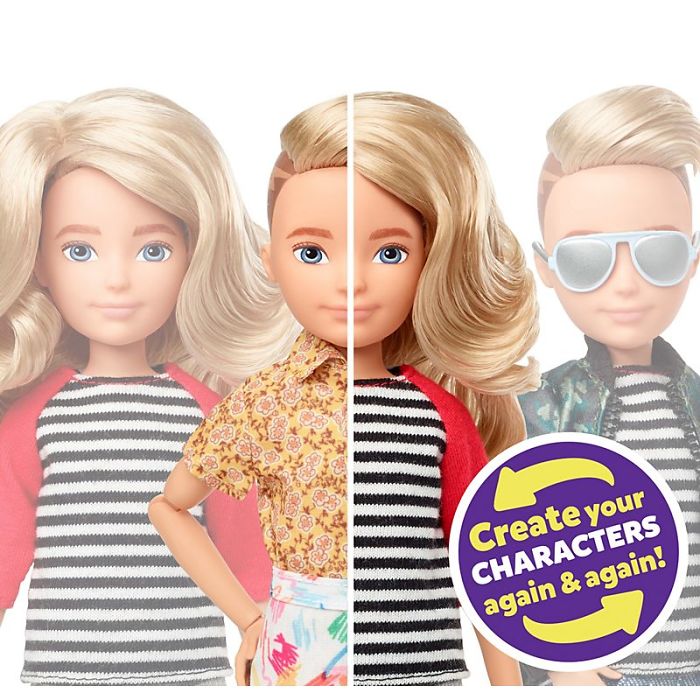
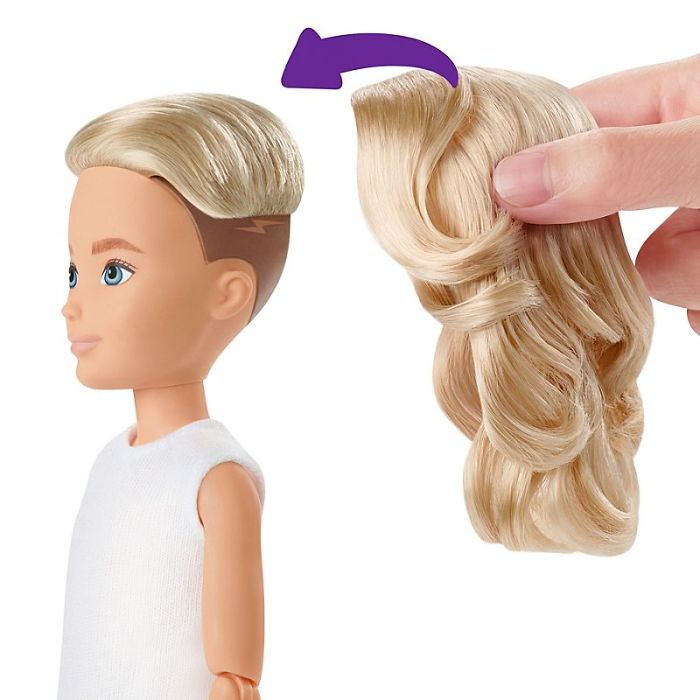
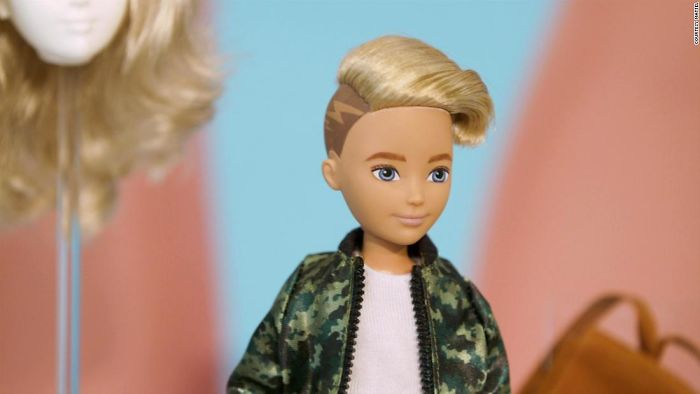
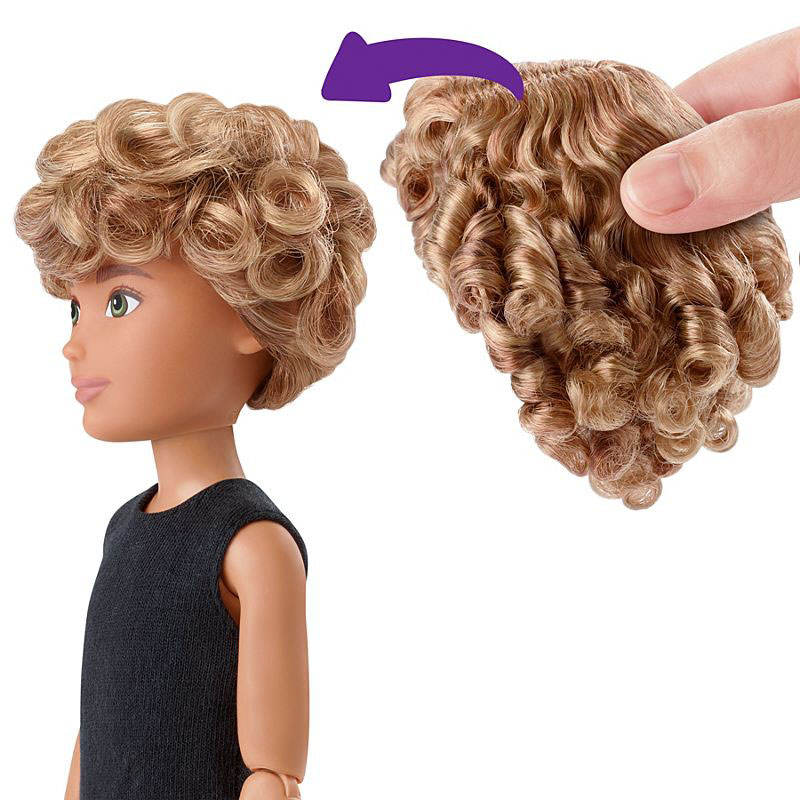
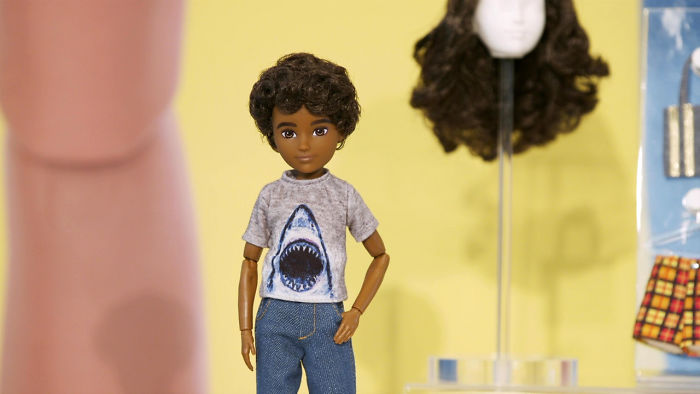
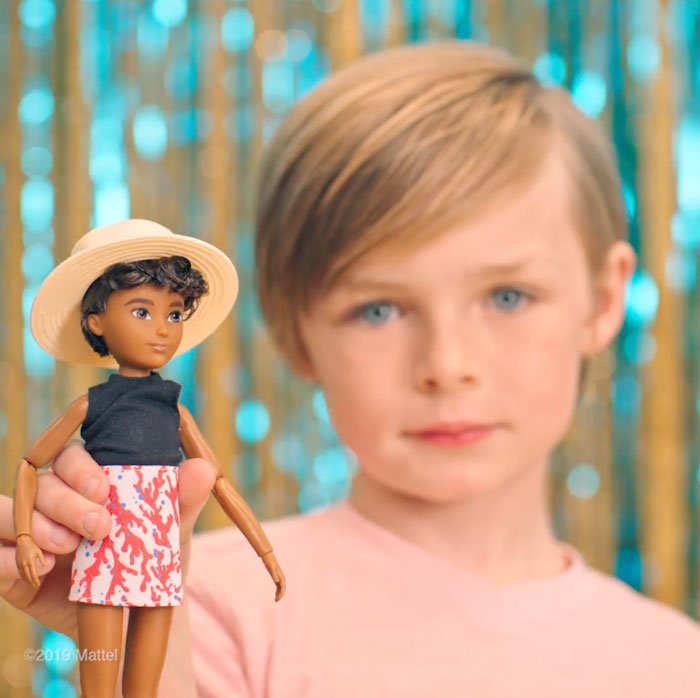
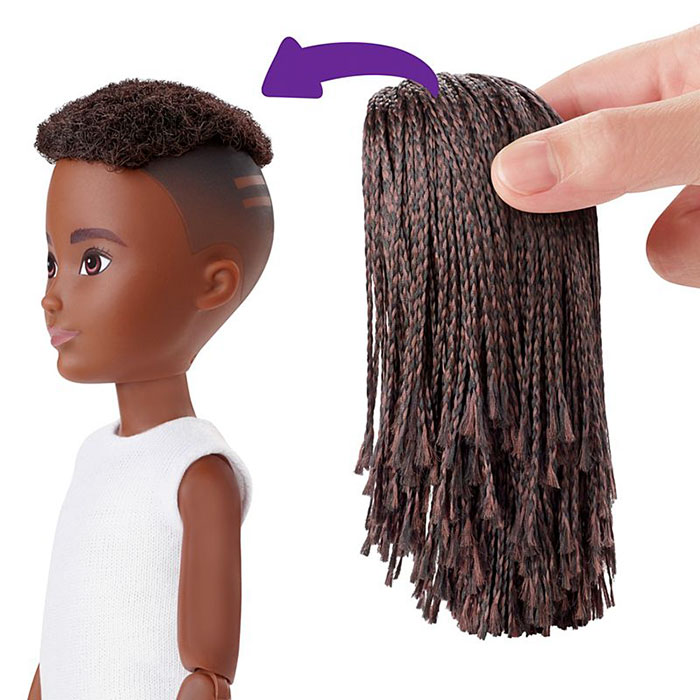
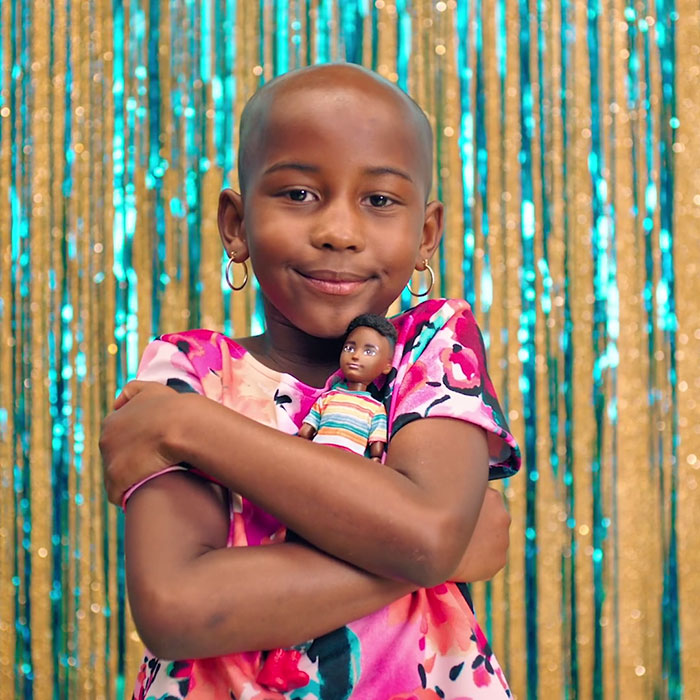
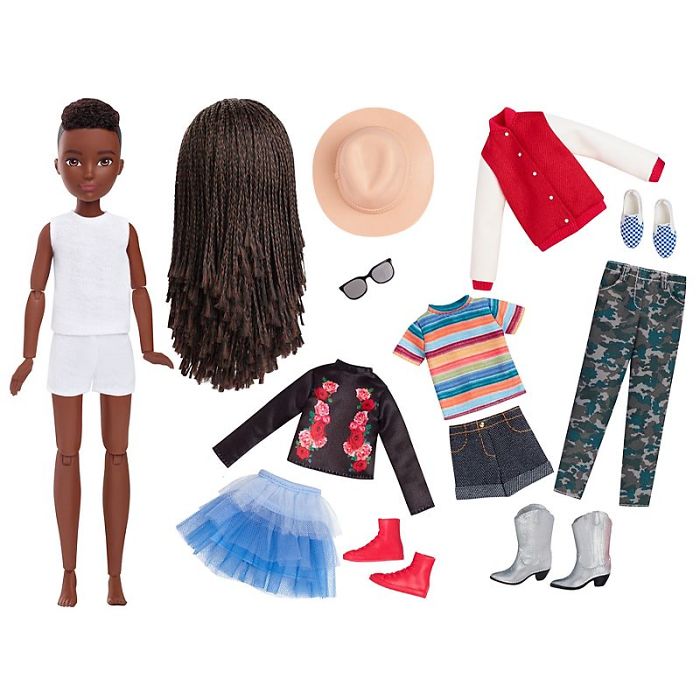
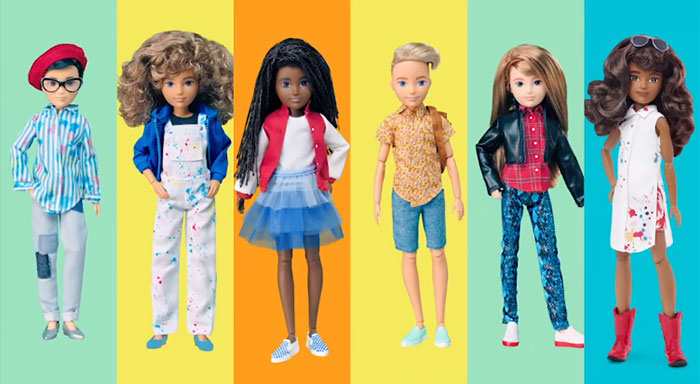
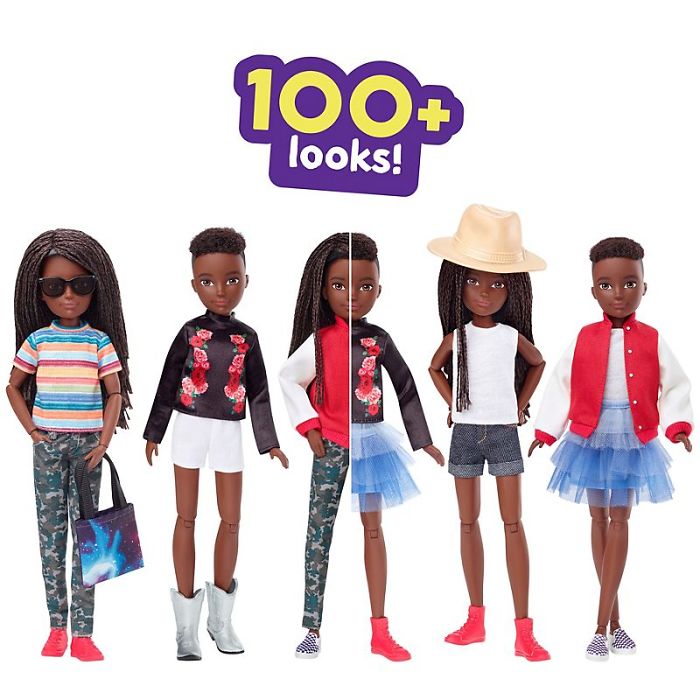
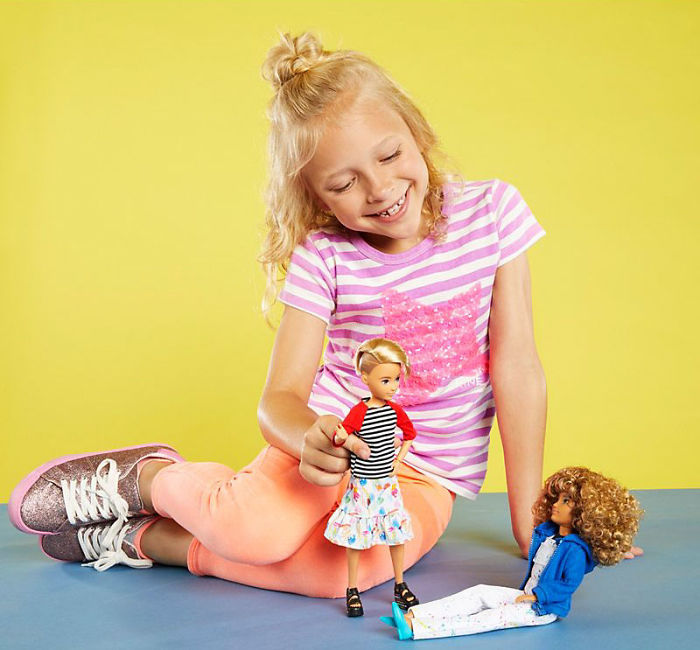
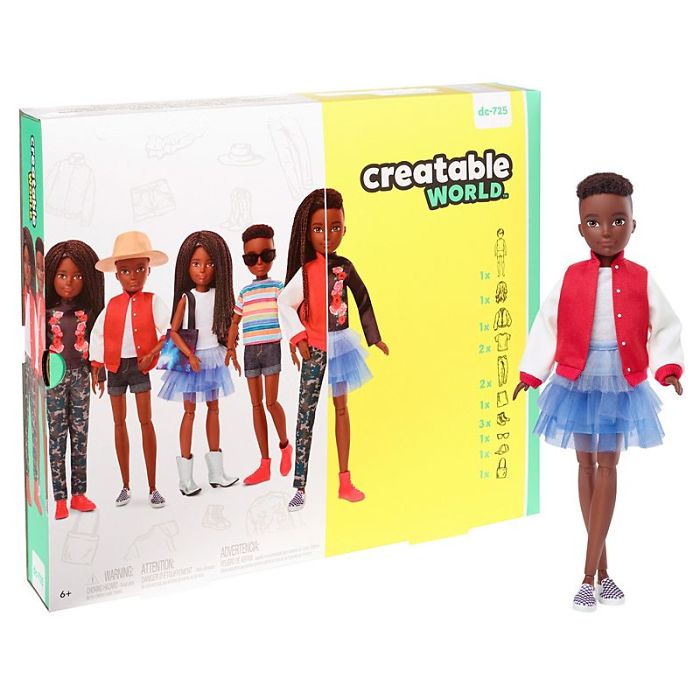
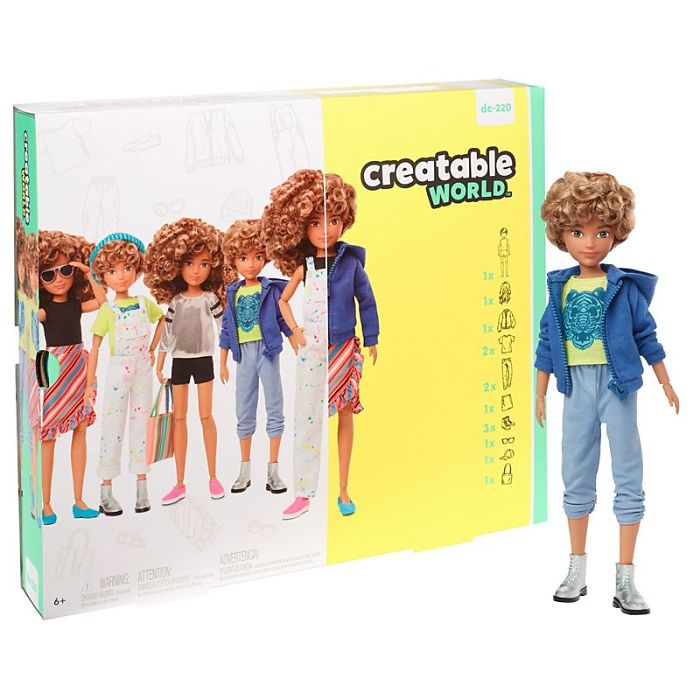
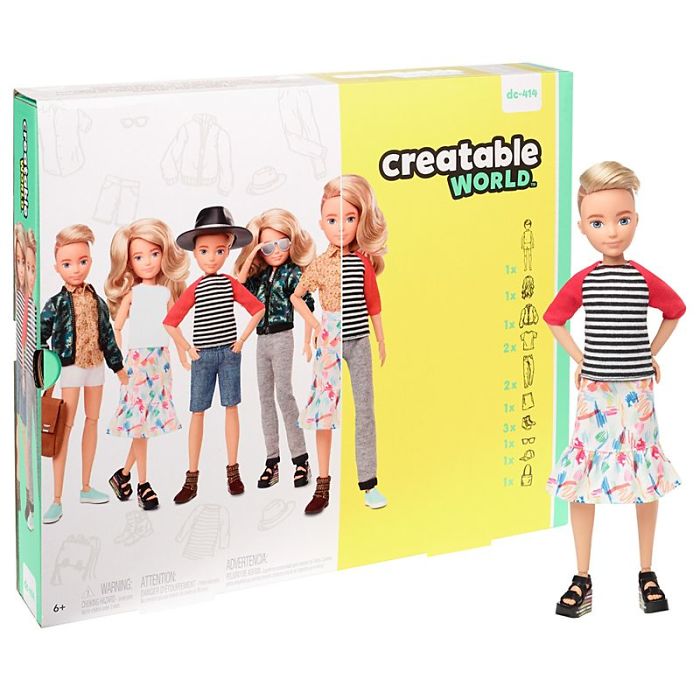
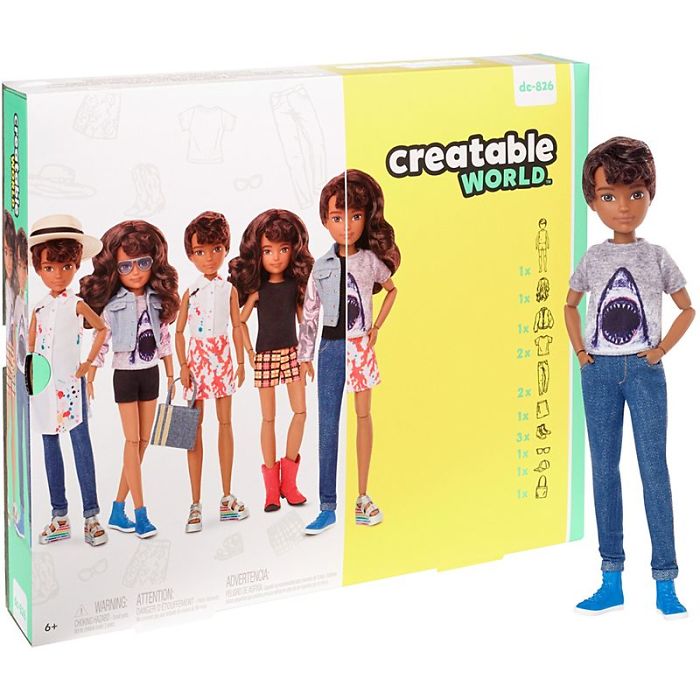



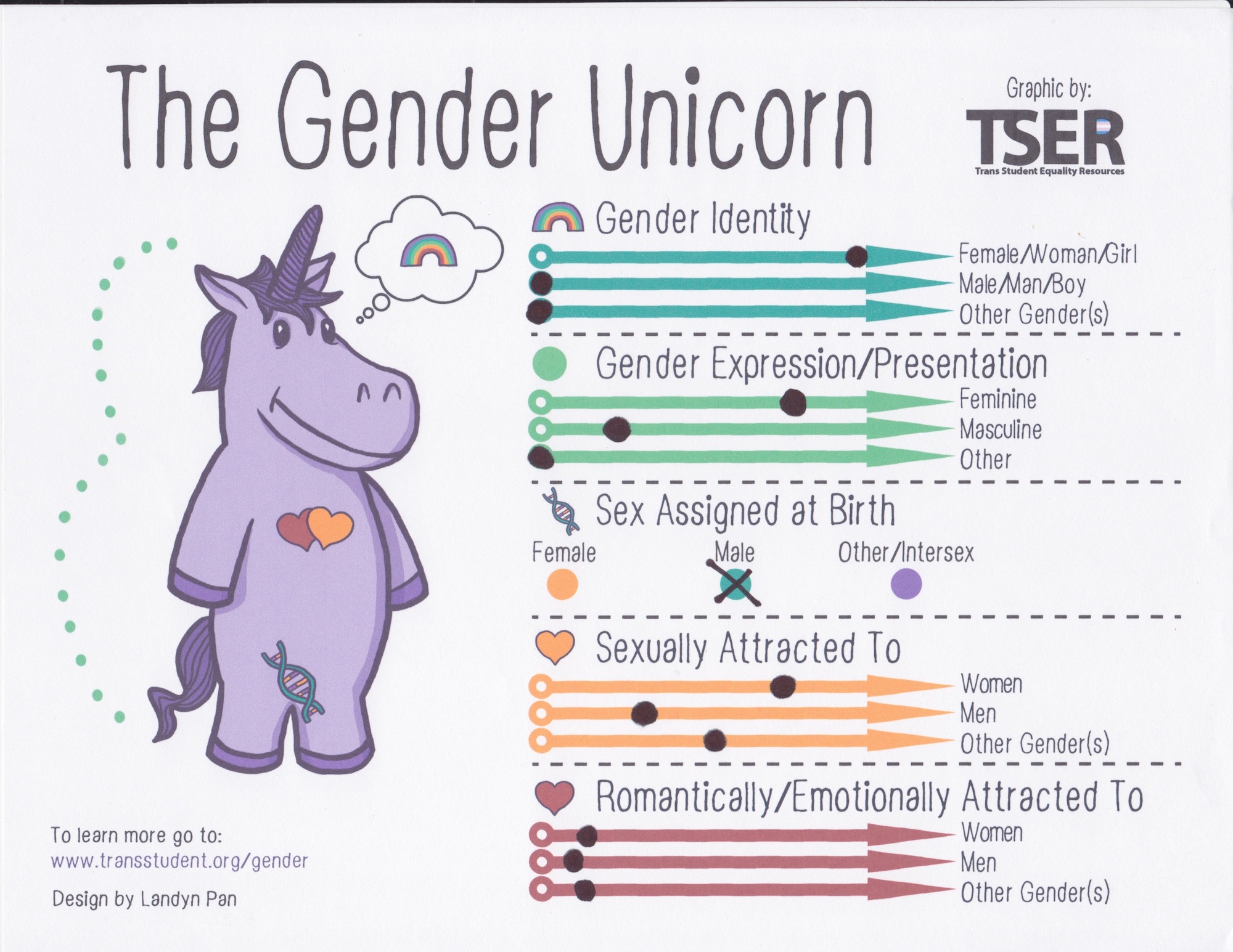

200
275